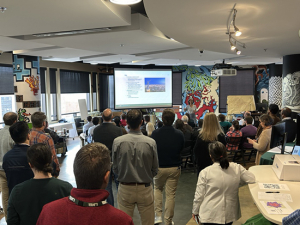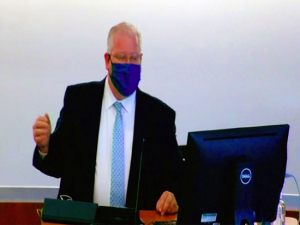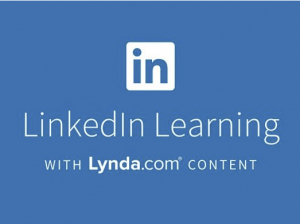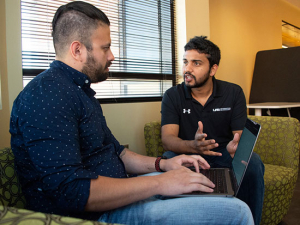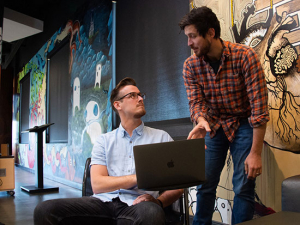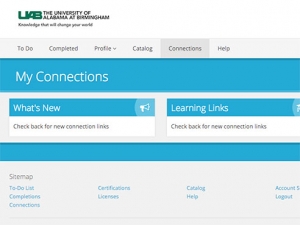 Jeffrey Holmes, M.D., Ph.D., dean of the School of Engineering, has used Dimensions software as part of a "crowd-sourced strategic planning process" at the school.Research topics, like social media networks and fashion, tend to experience sporadic waves of popularity, based partly on technical developments, partly on long-term trends and partly on politics. Building a successful research program, then, is a matter of investing in the topics that match the available talent, facilities and subjects that funding agencies are looking for. Of course, other universities are trying to do the same thing at the same time.
Jeffrey Holmes, M.D., Ph.D., dean of the School of Engineering, has used Dimensions software as part of a "crowd-sourced strategic planning process" at the school.Research topics, like social media networks and fashion, tend to experience sporadic waves of popularity, based partly on technical developments, partly on long-term trends and partly on politics. Building a successful research program, then, is a matter of investing in the topics that match the available talent, facilities and subjects that funding agencies are looking for. Of course, other universities are trying to do the same thing at the same time.
A new tool available to UAB faculty and staff promises to make researching research topics — a subject known as competitive intelligence and research analytics — easier than ever. Dimensions is an online software platform whose databases are crammed with information on the research lifecycle: 5.9 million grants awarded, millions of conference presentations, preprints and publications, and 177 million Altmetric data points derived from blog posts, tweets and other online mentions, 650,000 clinical trials and 138 million patents among them. Dimensions categorizes and groups this information by institution and researcher. Any member of the UAB community can set up a free account at app.dimensions.ai (see login instructions and case studies on the UAB Office of Research website).
Dimensions at the School of Engineering
Jeffrey Holmes, M.D., Ph.D., dean of the School of Engineering, was an early adopter at UAB. “We gave all our faculty access to Dimensions and asked them to use data to make the case for areas where we might want to invest in new faculty hiring to grow research,” Holmes said. During this “crowd-sourced strategic planning process,” Holmes asked faculty to identify areas that “1) would allow us to build upon or achieve state and regional leadership, 2) would span multiple departments within the school and connect to institutional strengths beyond the school, and 3) are growing nationally,” he explained.
Using Dimensions, the engineering faculty defined regional and institutional peer groups and then assessed publication activity at UAB relative to those groups to identify areas where UAB faculty have a competitive advantage and current or potential regional and/or national prominence.
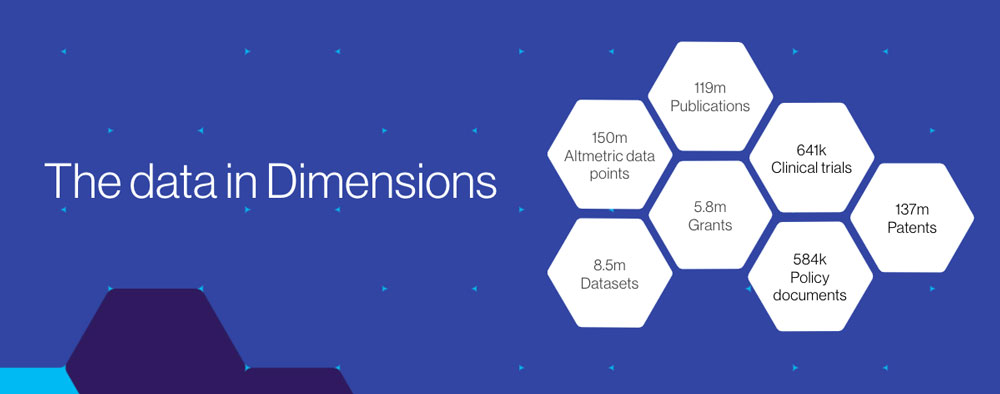
To identify potential partners at other departments and schools, faculty analyzed the funding agencies behind publications on topics of interest. That allowed them to home in on areas of focus and faculty working in those areas who could be approached to discuss partnerships. For example, identifying the National Institute of Mental Health as a key funder of work on a topic of interest at other regional leaders would suggest that new collaborations between the School of Engineering and UAB’s Department of Psychiatry might be successful.
Faculty also compared the future prospects of potential research topics by charting cumulative funding trends over the past decade or so for two or more areas of research interest.
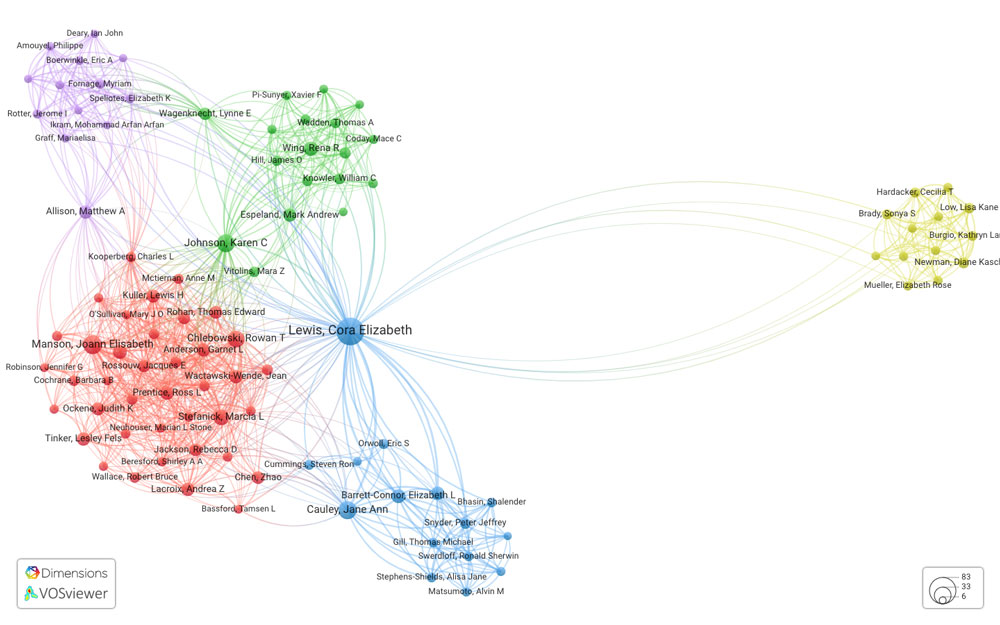 Dimensions allows users to study relationships between authors, topics and more. This example depicts co-authors of epidemiology department Chair Cora Lewis, Ph.D., one of UAB's most prolific authors.
Dimensions allows users to study relationships between authors, topics and more. This example depicts co-authors of epidemiology department Chair Cora Lewis, Ph.D., one of UAB's most prolific authors.Use cases from other institutions
What Holmes calls a “data-driven approach” to strategic planning is one potential use case for Dimensions. Others highlighted on the website of Dimensions maker Digital Science & Research Solutions include:
- Tracking publication history and growth of research collaborations to measure the postgraduate success of Ph.D. students. (Texas A&M)
- Using the text of a researcher’s grant proposal to find similar work being done by others in their field and identifying funders supporting that work. (University of Colorado)
- Finding grant application reviewers for internal funding award submissions by identifying researchers publishing in the relevant area. (University of Florida)
- Informing faculty hires by identifying subtopics of research that would best position the university for growth and mentioning those subtopics specifically in faculty postings. (University of Massachusetts-Lowell)
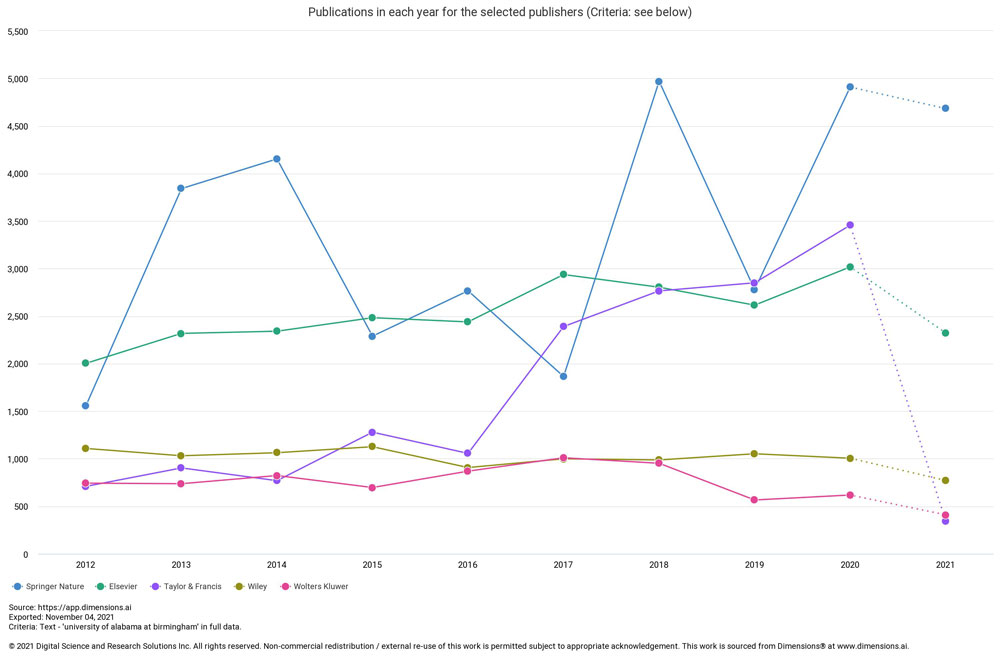 This chart depicts top publishers of articles by UAB authors, 2012-2021.
This chart depicts top publishers of articles by UAB authors, 2012-2021.
A quick-start guide
UAB’s Research Development Office has created a guide to getting started with Dimensions and setting up an account. They encourage members of the UAB research community to take a few minutes to try the tool.


